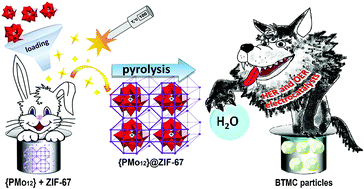Polyoxometalate encapsulation into metal–organic frameworks: the way towards functional nanomaterials for water splitting
Abstract
Today, the trapping of polyoxometalates (POMs) into different molecular assemblies represents a new emerging field of study. Herein we show the benefits of POM incorporation based on the example of a recently published achievement in the area of metal–organic frameworks (MOFs), where the transformation of low-cost noble-metal-free Keggin-POM@MOF hybrids through pyrolysis leads to small-sized bi-transition metal carbide particles opening up far-reaching opportunities for water splitting. The peculiarities of synthesis and reactivity of these unconventional Keggin-POM@MOF compounds are described. The bifunctional electrocatalytic activity of nanoparticles fabricated from the hybrids is emphasised with regard to reported catalytic systems of the same type. Overall, the synthetic strategy reported is expected to be used for the preparation of a novel type of POM@MOF hybrid where polyoxoanions are not only encapsulated in the MOF cages as commonly observed but also partially fenced by them, while blocking the POM withdrawal. This promises diverse attractive application prospects for POM@MOF hybrids in heterogeneous catalysis.

- This article is part of the themed collection: Recent Review Articles


 Please wait while we load your content...
Please wait while we load your content...